Florida has experienced more introductions of nonnative reptile species than any other region on Earth, and there are approximately three times as many species of established, nonnative lizards in the state as there are native species (Krysko et al. 2016). These established species range in size from the small (to 6 in.) Cuban brown anole (Anolis sagrei), to the large (to 7 ft.) Nile monitor (Varanus niloticus). Among Florida's approximately 50 species of nonnative lizards are four species within the family Agamidae. Agamid lizards are native to Africa, Asia, Australia, and Europe. Most of the roughly 500 known species are most active during the day and are visual hunters that feed on insects and other invertebrates (Vitt and Caldwell 2014). Within a species, males are often more boldly colored than females, at least during the breeding season.
The most widespread of the four agamid species with established populations in Florida is Peters's rock agama, which occurs in numerous scattered populations, mainly along coasts in the Peninsula (Figure 1). Peters's rock agama (Agama picticauda) are native to East Africa (The Reptile Database 2020). They were first introduced to Florida in 1976 via the pet trade (Wilson & Porras 1983; Nuñez et al. 2016). Initially believed to be the closely related red-headed agama or African rainbow lizard (Agama agama africana), a study of the lizard's DNA by University of Florida graduate student Leroy Nuñez showed otherwise (Nuñez et al. 2016). Based on this study, it is believed the species was introduced several times in the state by way of the exotic pet trade (Nuñez et al. 2016). The same reptile dealer was responsible for releasing the species in Homestead, Miami-Dade County, and Palm City, Martin County, where these populations have expanded widely (Enge et al. 2004).
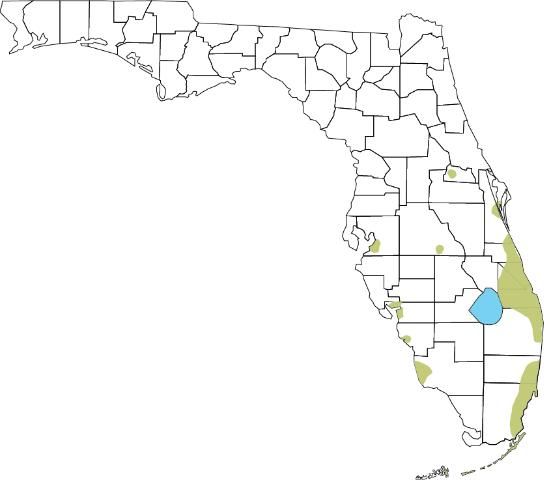
Identifying Peters's Rock Agama
Peters's rock agama are striking nonnative reptile species in Florida most notable because of the males' colorful skin and relatively large size as compared to Florida's native lizards. Adult males can grow to 12 in. including the tail, but females don't grow quite as large. In addition to their size difference, males and females may look very different. In Florida, adult males in breeding condition are boldly marked with an orange or red head, a black body, and a black-tipped tail immediately preceded by orange coloration (Figures 2 and 3).
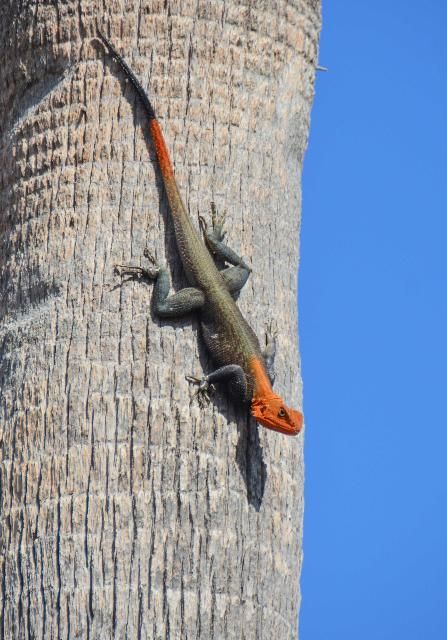
Credit: Pam Harting, Florida Master Naturalist
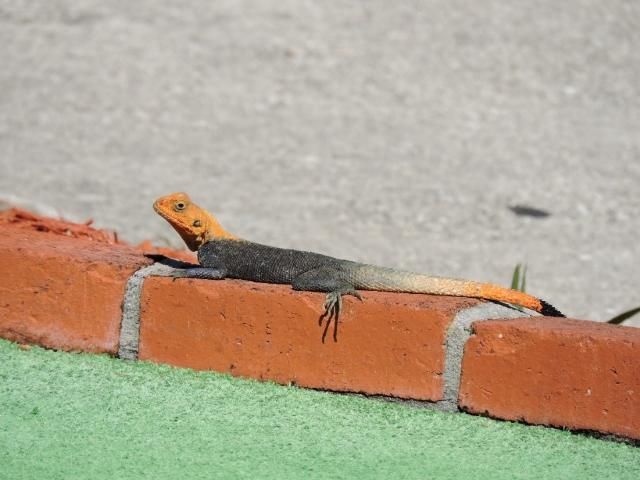
Credit: Sean McKnight, UF/IFAS Wildlife Ecology student.
The head coloration of mature, non-breeding males is not as bright, and the back is lighter colored. Breeding females are drab compared to breeding males, lacking orange or red coloration on their heads and tails, although females with eggs have yellow or orange patches on their body. They are brownish gray with light green spots and short stripes on their head and neck, and they frequently have a light band on the back of the thigh that extends onto the tail (Figure 4).
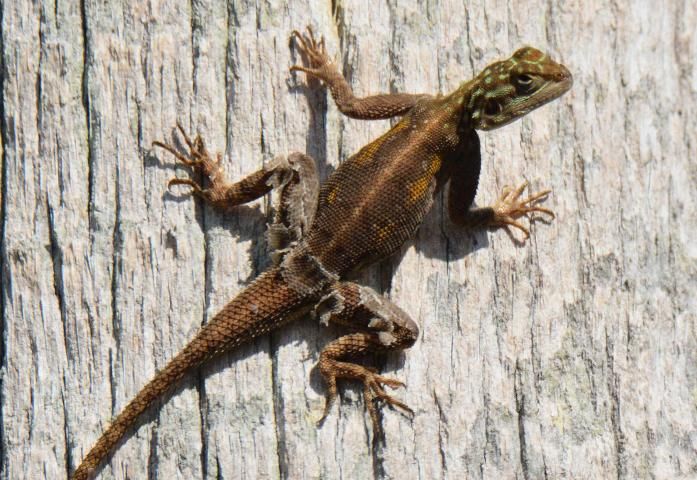
Credit: Pam Harting, Florida Master Naturalist
Juveniles look like females (Figure 5). Peters's rock agama scales are "keeled," meaning ridged and tapering to a pointed tip, giving the lizards a rough-textured look. The scales on their tail, legs, and along the center of their back are strongly keeled. They have wide, blocky heads, thin toes with claws, and long tails that do not easily break.
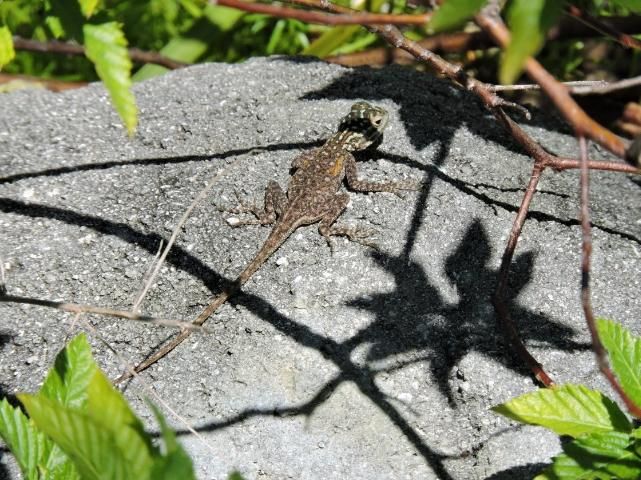
Credit: Sean McKnight, UF/IFAS Wildlife Ecology student
Peters's Rock Agama Ecology and "Natural History"
Peters's rock agama are largely confined to residential sites and human-dominated areas in Florida, and they do not normally appear to invade natural habitats (Krysko et al. 2019). They may be seen on building walls, fences, tree trunks, sidewalks, curbs, and pavement. They usually do not stray far from the cover of rocks, shrubs, and other hiding places. At one site near Punta Gorda, they live around a highway overpass and take refuge in the gaps between the concrete construction of the overpass. They are wary of people and quickly flee if approached too closely (Figure 6).
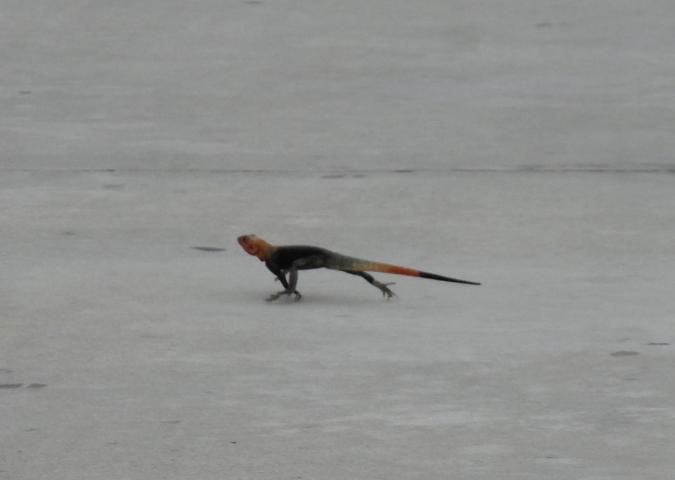
Credit: Ken Gioeli, UF/IFAS
Peters's rock agama can be dispersed accidentally by vehicles—a large agama was once observed falling from the undercarriage of a car traveling on an interstate highway (Moore 2019). Gray (2020) suggested their dispersal is also facilitated by railway lines when the lizards inadvertently hitchhike on freight shipped by train. Purposeful releases and "unintentional" modes of dispersal allow them to colonize new areas in Florida.
Peters's rock agama are carnivorous. In their native range of East Africa, they are mostly insectivorous but have also been observed eating small mammals, birds, small reptiles, and vegetation such as flowers, grasses, and fruit (Meshaka et al. 2004; Krysko et al. 2019). Like many lizards, they are sit-and-wait predators that sit on a perch and watch for crawling insects, then quickly run to capture their prey. Although their diet in Florida has not been studied, they likely feed on a variety of insects and other small invertebrates. We have seen video footage of a large male attempting to eat a monarch butterfly. Though the butterfly escaped, it lost a wing and likely died shortly thereafter. It is also possible that other nonnative lizards in Florida, such as the Cuban brown anole, are eaten by Peter's rock agama. Feeding on Cuban brown anoles has been documented for another introduced lizard in Florida, the northern curly-tailed lizard (Leiocephalus carinatus) (Barbosa 2017), which is smaller than the agama but has similar habitat use.
The reproductive season for Peters's rock agama in Florida is during the spring and summer. From April through August, females lay an average clutch size of seven to nine eggs (the number of eggs ranges from 5–12) with larger females having more eggs (Enge et al. 2004; Blunden and Krysko 2007). A female may lay 2–3 clutches of eggs annually (Krysko et al. 2019).
Though poorly documented, potential predators of Peters's rock agama probably include hawks as well as reptile-eating snakes, such as the southern black racer, and feral cats. Smaller agama are at greater risk of predation than adults, and it is possible that large adult agama occasionally eat small ones.
Impacts of Peters's Rock Agama in Florida
An invasive species is generally defined as a plant, animal, or microbe that is found outside of its native range, where it negatively impacts the ecology, economy, or quality of human life in the area where it was introduced by people. Presently, Peters's rock agama do not fit this definition, but they have not been studied in enough detail to rule out their potential for being considered invasive.
Ecological Harm
Although very little research has been conducted, it seems unlikely that Peters's rock agama have significant negative impacts on Florida's environment. This is mainly because they only occur in suburban areas that are dominated by people and development. As a result, there is little potential for Peters's rock agama to compete with native species for food or space. However, because they feed on insects and other small invertebrates, they do have the potential to negatively impact imperiled butterflies, especially in south Florida and the Keys. However, this has not been studied.
Human Quality-of-Life Impacts
Peters's rock agama do not pose a threat to pets or people. The bite of a large agama is potentially painful, but unless the lizard is being handled there is no chance of a bite. In fact, people often enjoy watching the behavior of these large, colorful lizards.
Economic Impacts
There are no known negative impacts of Peters's rock agama on Florida's economy. Some are even captured in Florida and sold in the pet trade, but they are not worth much money.
What You Can Do
University of Florida researchers and state agencies are trying to gain greater insight on nonnative reptiles and their distribution and impacts in Florida. It is important for people to report sightings of Peters's rock agama and other nonnative reptiles and amphibians. It is particularly important to report them in areas where they have not been documented previously (see Fig. 1 range map). For example, researchers are aware of Peters's rock agama in numerous locations within peninsular Florida, but only with the help of citizen scientists are researchers able to document new populations and expansion of known populations. You can engage in citizen science by reporting Peters's rock agama using the EDDMapS online mapping tool. Visit the EDDMapS website listed below to report a sighting of a Peters's rock agama or other nonnative animal.
Becoming better educated about nonnative and invasive species is something all Floridians can do to help our native plants and animals. It is unethical and against state law to release nonnative animals in Florida. So never release an unwanted exotic pet! The state of Florida operates an Exotic Pet Amnesty Program that helps people find homes for unwanted pet reptiles and other exotic animals. To learn more, visit the Florida Fish and Wildlife Conservation Commission's Pet Amnesty website.
Learning more about Florida's unique plants, animals, and ecosystems and then sharing that knowledge with others is a great way to become more environmentally literate and be an advocate for our native species. One way to do this is to get trained as a Florida Master Naturalist—see the link below to learn more about this award-winning program developed by the University of Florida.
Additional Sources of Information
EDDMaps: https://www.eddmaps.org/
FWC Pet Amnesty Program: https://myfwc.com/wildlifehabitats/nonnatives/amnesty-program/
Options for Unwanted Exotic Pets: https://edis.ifas.ufl.edu/uw353
Florida Master Naturalist Program: https://masternaturalist.ifas.ufl.edu/
Literature Cited
Barbosa, C. A. R. 2017. "Interspecific Interactions of Two Invasive Lizards in an Urban Environment." Unpublished MS Thesis, University of Florida. 78 pp.
Blunden, T. K., and K. L. Krysko. 2007. "Agama agama africana (African Rainbow Lizard) Reproduction." Herpetological Review 38: 73.
Enge, K. M., K. L. Krysko, and B. L. Talley. 2004. "Distribution and Ecology of the Introduced African Rainbow Lizard, Agama agama Africana (Suaria: Agamindae), in Florida." Florida Scientist 67: 303–310.
Gray, R. J. 2020. "Exotic Hobos: Release, Escape, and Potential Secondary Dispersal of African Red-Headed Agamas (Agama picticauda PETERS, 1877) through the Florida Railway Systems." BioRxiv. https://doi.org/10.1101/2020.05.11.089649
Krysko, K. L., K. M. Enge, and P. E. Moler. 2019. Amphibians and Reptiles of Florida. Gainesville: University of Florida Press. 706 pp.
Krysko, K. L., L. A. Somma, D. C. Smith, C. R. Gillette, D. Cueva, J. A. Wasilewski, K. M. Enge, S. A. Johnson, T. S. Campbell, J. R. Edwards, M. R. Rochford, R. Tompkins, J. L. Fobbs, S. Mullins, C. J. Lechowicz, D. Hazelton, and A. Warren. 2016. "New Verified Nonindigenous Amphibians and Reptiles in Florida through 2015, with a Summary of Over 152 Years of Introductions." IRCF Reptiles & Amphibians 23: 110–143.
Meshaka, W. E., B. P. Butterfield, and J. B. Hauge. 2004. The Exotic Amphibians and Reptiles of Florida. Malabar, FL: Krieger Publishing Company. 155 pp.
Moore, J. A. 2019. "Agama picticauda (Peter's Rock Agama) Dispersal." Herpetological Review 50: 360.
Nuñez, L. P., K. L. Krysko, and M. L. Avery. 2016. "Confirmation of Introduced Agama picticauda in Florida Based on Molecular Analyses." Bulletin of the Florida Museum of Natural History 54: 138–146.
Powell, R., R. Conant, and J. T. Collins. 2016. Peterson Field Guide to Reptiles and Amphibians of Eastern and Central North America. New York, NY: Houghton Mifflin Harcourt Publishing Company. 494 pp.
The Reptile Database. www.reptile-database.org. Accessed 23 June 2020
Vitt, L. J., and J. P. Caldwell. 2014. Herpetology: An Introductory Biology of Amphibians and Reptiles. London, UK: Elsevier Inc. 757 pp.
Wilson, L. D., and L. Porras. 1983. "The Ecological Impact of Man on the South Florida Herpetofauna." University of Kansas Museum of Natural History Special Publications 9: 1–89.